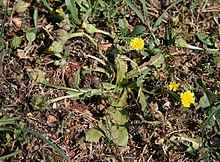
The genus Ophrys is a large group of orchids from the alliance Orchis in the subtribe Orchidinae. They are widespread across much of Europe, North Africa, Caucasus, the Canary Islands, and the Middle East as far east as Turkmenistan.

Erica arborea, the tree heath or tree heather, is a species of flowering plant (angiosperms) in the heather family Ericaceae, native to the Mediterranean Basin and Ethiopia, Kenya and Tanzania in East Africa. It is also cultivated as an ornamental.

Limonium is a genus of 120 flowering plant species. Members are also known as sea-lavender, statice, caspia or marsh-rosemary. Despite their common names, species are not related to the lavenders or to rosemary. They are instead in Plumbaginaceae, the plumbago or leadwort family. The generic name is from the Latin līmōnion, used by Pliny for a wild plant and is ultimately derived from the Ancient Greek leimon.

Portulaca (, is the type genus of the flowering plant family Portulacaceae, with over 100 species, found in the tropics and warm temperate regions. They are known as the purslanes.
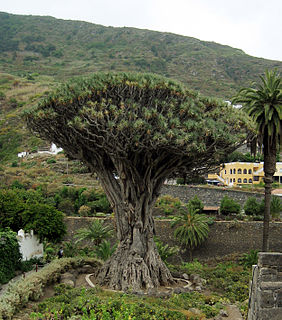
Dracaena draco, the Canary Islands dragon tree or drago, is a subtropical tree in the genus Dracaena, native to the Canary Islands, Cape Verde, Madeira, western Morocco, and is thought to be introduced in the Azores. Its closest living relative is the dragon blood tree of Socotra, Dracaena cinnabari.

Gran Canaria Airport, sometimes also known as Gando Airport, is a passenger and freight airport on the island of Gran Canaria. It is an important airport within the Spanish air-transport network, as it holds the sixth position in terms of passengers, and fifth in terms of operations and cargo transported. It also ranks first of the Canary Islands in all three categories, although the island of Tenerife has higher passenger numbers overall if statistics from the two airports located on the island are combined.

In biogeography, the Mediterranean Basin is the region of lands around the Mediterranean Sea that have mostly a Mediterranean climate, with mild to cool, rainy winters and warm to hot, dry summers, which supports characteristic Mediterranean forests, woodlands, and scrub vegetation.

Dysdera is a genus of woodlouse hunting spiders that was first described by Pierre André Latreille in 1804. They originated from Central Asia to Central Europe.

Pancratium is a genus of African and Eurasian perennial, herbaceous and bulbous plants in the Amaryllis family, subfamily Amaryllidoideae

Micromeria is a genus of flowering plants in the mint family, Lamiaceae, widespread across Europe, Asia, Africa, and North America, with a center of diversity in the Mediterranean region and the Canary Islands. It is sometimes placed within the genus Satureja. The name is derived from the Greek words μῑκρος (mīkros), meaning "small," and μερίς (meris), meaning "portion," referring to the leaves and flowers.
- Micromeria acropolitanaHalácsy - Greece
- Micromeria albanica(K.Malý) Šilic - Albania, Yugoslavia
- Micromeria × angosturaeP.Pérez Gran Canaria in the Canary Islands (M. tenuis subsp. linkii × M. varia subsp. canariensis)
- Micromeria arganietorum(Emb.) R.Morales - Morocco
- Micromeria benthamiiWebb & Berthel. - Gran Canaria in the Canary Islands
- Micromeria × benthamineolensSvent. - Gran Canaria in the Canary Islands (M. benthamii × M. pineolens)
- Micromeria biflora(Buch.-Ham. ex D.Don) Benth. - Himalayas from Afghanistan to Myanmar
- Micromeria × bourlieriMaire & Le Lièvre - Algeria, Morocco (M. graeca × M. inodora)
- Micromeria brivesiiBatt. - Morocco
- Micromeria × broussonetiiA.Santos, A.Acev.-Rodr. & Reyes-Bet. - Canary Islands (M. densiflora × M. varia)
- Micromeria browicziiZiel. & Kit Tan - Greece
- Micromeria chionistraeMeikle - Cyprus
- Micromeria conferta(Coss. & Daveau) Stefani - Libya
- Micromeria × confusaG.Kunkel & P.Pérez - Gran Canaria in the Canary Islands (M. benthamii × M. lanata)
- Micromeria cremnophilaBoiss. & Heldr. - Albania, Greece, Turkey, Syria, Lebanon
- Micromeria cristata(Hampe) Griseb. - Albania, Greece, Yugoslavia, Turkey, Bulgaria, Iran, Cyprus
- Micromeria croatica(Pers.) Schott - Albania, Yugoslavia
- Micromeria cymuligeraBoiss. & Hausskn. - Turkey
- Micromeria danaensisDanin - Jordan
- Micromeria debilisPomel - Algeria, Morocco
- Micromeria densifloraBenth. - Tenerife in the Canary Islands
- Micromeria ellipticaK.Koch - Turkey
- Micromeria filiformis(Aiton) Benth. - Corsica, Sardinia, Balearic Islands
- Micromeria flacca(Nábelek) Hedge - Turkey, Iraq
- Micromeria flagellarisBaker - Madagascar
- Micromeria fontanesiiPomel - Algeria, Morocco
- Micromeria forbesiiBenth. - Cape Verde Islands
- Micromeria fruticosa(L.) Druce - Eastern Mediterranean
- Micromeria glomerataP.Pérez - Tenerife in the Canary Islands
- Micromeria graeca(L.) Benth. ex Rchb. - Mediterranean from Morocco + Portugal to Turkey
- Micromeria guichardii(Quézel & Zaffran) Brullo & Furnari - Libya
- Micromeria hedgeiRech.f. - Iran
- Micromeria helianthemifoliaWebb & Berthel. - Gran Canaria in the Canary Islands
- Micromeria herpyllomorphaWebb & Berthel. - La Palma in the Canary Islands
- Micromeria hispidaBoiss. & Heldr. ex Benth. - Crete
- Micromeria hochreutineri(Briq.) Maire - Algeria, Morocco
- Micromeria × hybridaZagan - Greece including Crete (M. graeca × M. nervosa)
- Micromeria hyssopifoliaWebb & Berthel. - Tenerife + El Hierro in the Canary Islands
- Micromeria imbricata (Forssk.)C.Chr. - Africa from Nigeria to Ethiopia to Transvaal, Arabian Peninsula
- Micromeria inodora(Desf.) Benth. - Algeria, Morocco, Tunisia, Spain including Balearic Islands
- Micromeria × intermediaG.Kunkel & P.Pérez - Gran Canaria in the Canary Islands (M. benthamii × M. helianthemifolia)
- Micromeria juliana(L.) Benth. ex Rchb. - Mediterranean
- Micromeria kerneriMurb. - Yugoslavia
- Micromeria lachnophyllaWebb & Berthel. - Tenerife in the Canary Islands
- Micromeria lanata(C.Sm. ex Link) Benth. - Gran Canaria in the Canary Islands
- Micromeria lasiophyllaWebb & Berthel. - Canary Islands
- Micromeria lepidaWebb & Berthel. La Gomera in the Canary Islands
- Micromeria leucanthaSvent. ex P.Pérez - Gran Canaria in the Canary Islands
- Micromeria longipedunculataBräuchler - Yugoslavia, Albania
- Micromeria macrosiphonCoss. - Morocco
- Micromeria madagascariensisBaker - Madagascar
- Micromeria marginata(Sm.) Chater - Alpes Maritimes in France, Liguria + Sardinia in Italy
- Micromeria × meteoricaHausskn. - Greece (M. cremnophila × M. juliana)
- Micromeria microphylla(d'Urv.) Benth. - Balearic Islands, Sicily, Malta, southern mainland Italy, Crete, Cyprus, Libya
- Micromeria monantha(Font Quer) R.Morales - Morocco
- Micromeria myrtifoliaBoiss. & Hohen. - from Greece to Iran
- Micromeria nervosa(Desf.) Benth. - Mediterranean from Algeria + Balearic Islands to Turkey
- Micromeria × nogalesiiG.Kunkel & P.Pérez - Gran Canaria in the Canary Islands
- Micromeria peltieri(Maire) R.Morales - Morocco
- Micromeria × perez-paziiG.Kunkel - Gran Canaria in the Canary Islands (M. benthamii × M. tenuis)
- Micromeria persicaBoiss. - Iran, Iraq, Turkey
- Micromeria pineolensSvent. - Gran Canaria in the Canary Islands
- Micromeria × preauxiiWebb & Berthel. - Gran Canaria in the Canary Islands (M. benthamii × M. varia subsp. canariensis)
- Micromeria pseudocroaticaŠilic - Yugoslavia
- Micromeria rivas-martineziiWildpret - Tenerife in the Canary Islands
- Micromeria serbalianaDanin & Hedge - Sinai
- Micromeria sinaicaBenth. - Sinai, Israel
- Micromeria sphacioticaBoiss. & Heldr. ex Benth.- Crete
- Micromeria sphaerophyllaBaker - Madagascar
- Micromeria suborbicularis(Alain) Borhidi - Cuba
- Micromeria × tagananensisP.Pérez - Tenerife in the Canary Islands (M. glomerata × M. varia)
- Micromeria teneriffae(Poir.) Benth. ex G.Don - Tenerife in the Canary Islands
- Micromeria tenuis(Link) Webb & Berthel. - Gran Canaria in the Canary Islands
- Micromeria unguentariaSchweinf. - Ethiopia
- Micromeria variaBenth. - Canary Islands, Madeira, Cape Verde Islands
- Micromeria weilleri(Maire) R.Morales - Morocco
- Micromeria × wildpretiiP.Pérez - Tenerife in the Canary Islands (M. rivas-martinezii × M. varia)

Vulpia is a widespread genus of plants in the grass family, native to many countries around the world and naturalized in many of the nations to which it is not native. It is most common in temperate regions.
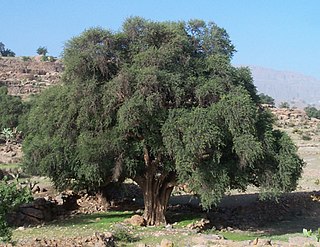
The Mediterranean Acacia-Argania dry woodlands and succulent thickets is a Mediterranean forests, woodlands, and scrub ecoregion in North Africa centered mainly on Morocco but also including northwestern Western Sahara and the eastern Canary Islands.

Himantoglossum is a genus of orchids native to the Canary Islands, Europe, southwest Asia and northern Africa. Its members generally have a labellum which is divided into three parts, of which the middle part is the longest.
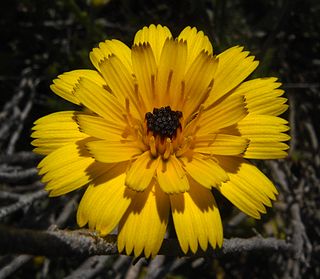
Tolpis is a genus of flowering plants in the tribe Cichorieae within the family Asteraceae. It is native to Africa, Southern Europe, the Middle East and Macaronesia. Many species are limited to the Canary Islands.

Urospermum, or prickly goldenfleece, is a small genus of flowering plants in the dandelion tribe within the daisy family.

Rhagadiolus is a genus of plants in the tribe Cichorieae within the family Asteraceae, native to the Mediterranean region of southern Europe, northern Africa, and the Middle East.

Scorzoneroides or hawkbits is a genus of plants of the tribe Cichorieae within the family Asteraceae.

Charles-Joseph Marie Pitard, name sometimes given as Charles-Joseph Marie Pitard-Briau was a French pharmacist and botanist.

Hedypnois rhagadioloides, the Cretanweed or scaly hawkbit, is a species of plant in the tribe Cichorieae within the family Asteraceae. It is native to the Mediterranean Region and neighboring areas from Canary Islands to Iran, and naturalized in Australia and in parts of the Americas.
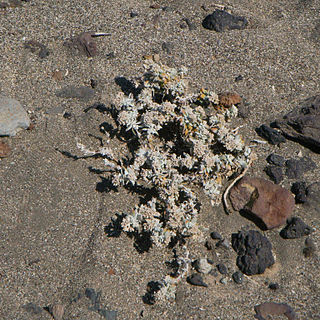
Polycarpaea nivea is a species of flowering plants in the family Caryophyllaceae. The species was described by William Aiton in 1828 as Achyranthes nivea, and it was placed in the genus Polycarpaea by Philip Barker Webb in 1849. The specific name nivea is Latin for "white as snow", and refers to the colour of the plant.
